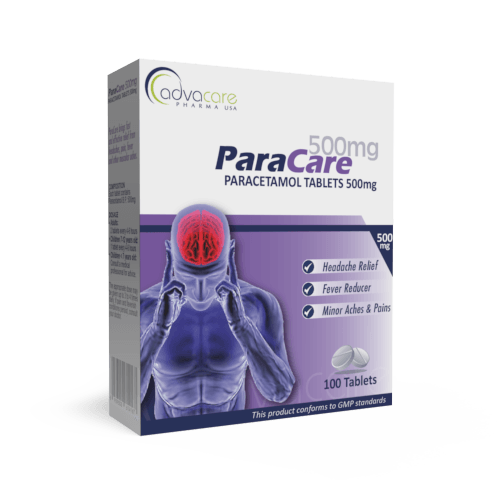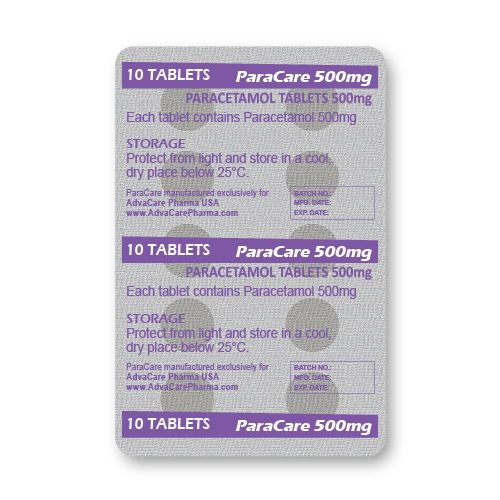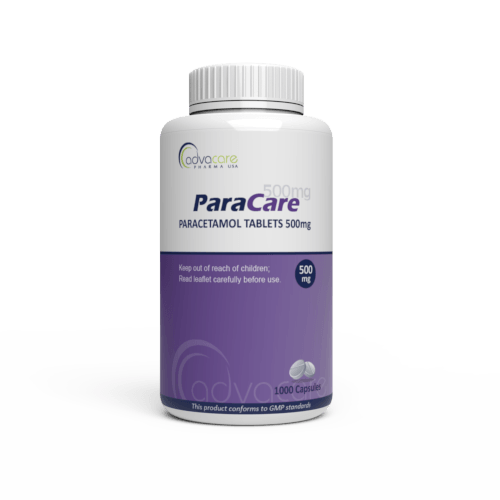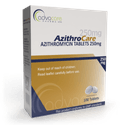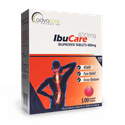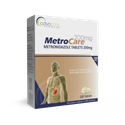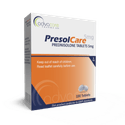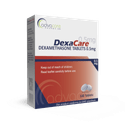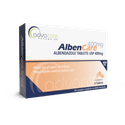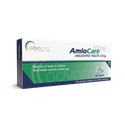- Home›
- Pharmaceuticals›
- Pharmaceutical Tablets›
- Paracetamol Tablets
Paracetamol Tablets
Dosage
Packaging
What is Paracetamol?
Active Ingredients: Paracetamol
Paracetamol Tablets are a drug used to relieve mild to moderate pain. This medication may also be used to reduce fever in adults or children. This medication provides effective pain relief and is safe and effective when used for short-term relief. It is a first-line therapy for pain conditions, as recommended by the World Health Organization (WHO).
Paracetamol, also known as acetaminophen, belongs to the classes of medications called analgesics (pain relievers) and antipyretics. It is the most commonly over-the-counter taken analgesic in the world. Paracetamol demonstrates a strong capacity for pain management but exhibits weak anti-inflammatory activity. Though it is unclear the exact site of action, the active ingredient may work by either inhibiting prostaglandin synthesis or by activating descending serotonergic pathways.
Paracetamol is thought to indirectly inhibit the cyclooxygenase (COX) pathways and exert central actions that ultimately alleviate pain symptoms. Its antipyretic effects are likely the result of its action at heat-regulating centers in the brain that result in peripheral vasodilation, sweating, and loss of body heat.
AdvaCare Pharma is a global supplier of Paracetamol Tablets, Capsules, Oral Suspensions, and Injections. Our medical products are manufactured in our facilities in China, India, and the USA. Our factories are routinely inspected to ensure they meet the high standards necessary to comply with WHO guidelines and standards.
Why are we a top Paracetamol manufacturer?
AdvaCare Pharma is a trusted Paracetamol manufacturer committed to providing quality-assured, cost-effective pharmaceuticals for an ever-changing global market. Manufacturing a wide range of 200+ pharmaceutical products in tablet form, we ensure that all of our oral solid dosage forms adhere to stringent GMP standards.
We operate according to a unique "vested supplier-distributor relationship" business model, in which we tie our success in a market to that of our distributor. Such a model facilitates a closer relationship by working together to achieve pre-defined goals for market entry and expansion. As a Paracetamol manufacturer and global supplier, we implement unique strategies to ensure successful distribution.
Uses
What is Paracetamol (Acetaminophen) used for?
It is used to reduce pain caused by conditions like headaches (including migraines and tension headaches), toothache, nerve pain, backache, muscle pain, joint pain, sore throat, and dysmenorrhea. It may also be used to reduce fever and relieve cold or flu symptoms. Paracetamol is also a safe and effective analgesic/antipyretic drug for children.
How should Paracetamol Tablets be used?
This medication is intended to be taken orally. They can be taken with or without food.
What dose should be taken and how often?
For the treatment of mild to moderate pain and fever:
- Adults and children (≥ 12 years; ≥ 50kg) can take 250-1000mg every 4 to 6 hours. Do not exceed single doses of 1000mg OR a daily maximum of 4000mg.
- Children (< 12 years; < 50kg) can take 10-15mg/kg every 4 to 6 hours. Do not exceed 5 doses in 24 hours OR a daily maximum of 75mg/kg/day. For more accurate weight-based dosing, Paracetamol Oral Suspension is recommended.
Maximum doses are based on all routes of administration and all products containing paracetamol. Refer to a doctor or pharmacist for guidelines on dosage. Do not exceed what they advise.
Who can use Paracetamol?
Paracetamol Tablets can be taken by adults and children, but caution is advised for specific groups of patients.
Pregnant Animal studies of acetaminophen use have found evidence of adverse fetal and maternal events, including liver and kidney necrosis, at doses exceeding the maximum human daily dose by factors of 0.85(3400mg) and 1.2(4800mg). Large human studies of paracetamol use during the first trimester of pregnancy have not revealed definitive evidence of drug-associated risks of major birth defects, miscarriage, or other adverse maternal or fetal outcomes.
Paracetamol during pregnancy has failed to show an increase in the frequency of adverse fetal events and may be safe to use during pregnancy.
Animal studies have found that paracetamol administration may reduce fertility. It was associated with decreased testicular weight, reduced spermatogenesis, and reduced fertility in males and reduced implantation sites in females.
Nursing Paracetamol/acetaminophen is excreted into human milk in small amounts. The effects on nursing infants are unknown. Caution is recommended when using paracetamol in nursing patients. Nursing infants should be closely monitored for any potential adverse effects. The benefits of breastfeeding, the potential patient benefits, and the potential infant risks should all be considered when considering paracetamol use while nursing.
Pediatric In patients < 2 years old, the efficacy of paracetamol for the treatment of acute pain has not been established.
In patients > 2 years old, the efficacy and safety of paracetamol for the treatment of fever have been demonstrated in clinical studies.
Geriatric Studies have not found differences in paracetamol’s safety or efficacy in older adults (≥ 65 years) when compared to younger adults. Age-related decreases in hepatic and renal function and an increased sensitivity to drugs should be considered when administering paracetamol to older patients. Dosage reductions and organ function monitoring may be necessary.
Paracetamol/acetaminophen is recommended by the American Geriatrics Society as the first-line medication when treating mild to moderate pain in older patients.
Are Paracetamol Tablets the same as Ibuprofen Tablets?
Paracetamol and ibuprofen are both widely used over-the-counter medications for pain relief and fever reduction, but they have different mechanisms of action. Paracetamol works primarily on the central nervous system to alleviate pain and reduce fever, making it a suitable choice for various conditions. On the other hand, ibuprofen belongs to the class of nonsteroidal anti-inflammatory drugs (NSAIDs) and works by inhibiting the production of certain chemicals that cause inflammation in the body.
This dual action makes ibuprofen effective not only in pain relief but also in reducing inflammation and swelling. It is essential to consider individual health conditions, and possible side effects, and consult with health professionals for guidance on the proper use of each.
Other warnings
In patients with severe hepatic impairment or disease, paracetamol use is contraindicated. In patients with mild to moderate hepatic insufficiency, caution should be exercised, and dosage reductions may be necessary.
Doses exceeding the recommended daily limit may result in hepatic injury, severe hepatotoxicity, and death. Do not exceed the maximum daily dose based on patient weight. Concomitant use with other medications containing paracetamol is contraindicated. Concomitant use of paracetamol with 3 or more alcoholic drinks a day can increase the hepatotoxic potential of both agents. Signs of hepatic injury that may require medical attention are nausea, vomiting, loss of appetite, sweating, fatigue, jaundice (yellowing of the skin or eyes), dark urine, light-colored stool, pain in the upper abdominal area above the liver, and itching.
In patients with severe renal insufficiency, longer dosing intervals and reduced daily dosages may be necessary.
Hypersensitivity and anaphylaxis reactions have been reported with paracetamol use. Symptoms can include difficulty breathing, swelling of the face, mouth, or throat, rash, hives, and itchy skin. Rare, potentially fatal adverse skin reactions, including acute generalized exanthematous pustulosis (AGEP), Stevens-Johnson Syndrome (SJS), and toxic epidermal necrolysis (TEN), have been reported. Paracetamol should be discontinued immediately at the first sign of skin rash, especially in the presence of blistering or peeling, or other signs of hypersensitivity reactions.
Paracetamol overdoses can cause liver damage or death. Early signs of overdose include loss of appetite, nausea, vomiting, sweating, and weakness. Symptoms that may develop later include yellowing of the skin or eyes (jaundice), dark urine, pain in the liver area (upper right abdomen). Additional symptoms can include irritability, hunger, rapid heart rate, tremors, restlessness, difficulty concentrating, easy or unusual bruising, and purple or red pinpoint spots under the skin.
Paracetamol should be administered with caution in patients with hepatic impairment or disease, alcohol use disorder, chronic malnutrition, severe hypovolemia, and severe renal impairment.
Paracetamol has been found to interfere with continuous glucose monitoring (CGM) sensors, resulting in falsely elevated blood glucose (BG) values when compared to BG meter values. This may have clinical consequences for patients with diabetes who are using CGM values instead of BG values and who are using CGM values in a closed-loop system for automated insulin delivery. The FDA currently recommends that BG values are used instead of CGM values when making insulin dosing decisions.
CYP2E1 inductors and inhibitors may impact paracetamol’s metabolism and increase its hepatotoxic potential. The clinical consequences of these effects have not been established.
Oral doses of 4000mg/day of paracetamol have been shown to increase international normalized ratio (INR) in some patients taking the anticoagulant sodium warfarin. Patients taking anticoagulants may warrant INR assessment while taking Paracetamol Tablets.
Side Effects
As with all pharmaceuticals, some unwanted effects can occur from the use of Paracetamol Tablets.
Common side effects include, but may not be limited to:
- nausea
- diarrhea
- constipation
- vomiting
- headache
- tiredness or weakness
Seek medical attention if the following develop:
- swelling
- difficulty swallowing or breathing
- hives or skin rash or peeling
- unexplained or easy bruising or bleeding
- unusual stomach ache or pain
- signs of liver injury (yellowing of the skin or eyes, unexplained weight loss, loss of appetite)
For a comprehensive understanding of all potential side effects, consult a medical professional.
If any symptoms persists or gets worse, or you notice any other symptoms, please call your doctor.
Precautions
Do NOT use Paracetamol (Acetaminophen) Tablets if:
- You are allergic to paracetamol or any of its ingredients.
- You have liver disease or a history of alcohol use disorder.
- You have severe kidney problems.
Alcohol should be avoided, as it may increase the chance of liver damage when combined with paracetamol.
Adhere strictly to the recommended dosage. Exceeding the recommended amount can lead to severe liver damage.
Before treatment, consult your doctor regarding any medications you are taking to address potential drug interactions.
This medication may not be suitable for people with certain conditions, so it is important to consult with a doctor if you have any health conditions.
References
Single dose oral paracetamol (acetaminophen) for postoperative pain
This review aimed to evaluate the efficacy of single oral doses of paracetamol in treating acute postoperative pain.
Randomized, double-blind, placebo-controlled trials involving paracetamol treatment for acute postoperative pain in adults were included in this study.
The analysis included 47 reports comprising 4186 patients, with 2561 patients receiving a single oral dose of paracetamol and 1625 receiving placebo. The number-needed-to-treat (NNTs) for at least 50% pain relief over four to six hours following different doses of paracetamol ranged from 3.5 to 4.6. Subgroup analyses showed no significant differences between smaller and larger trials or lower and higher quality trials.
The conclusion of this study is that single doses of paracetamol are effective in relieving acute postoperative pain.

You might be interested in...
Why AdvaCare Pharma?
As an industry leader, we are aware of our responsibility to provide affordable and sustainable solutions to improve healthcare worldwide.
